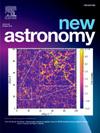An elaborate search for coherent pulsations from Intermittent–AMXPs
IF 2.1
4区 物理与天体物理
Q2 ASTRONOMY & ASTROPHYSICS
引用次数: 0
Abstract
We present a detailed systematic pulse search for three Intermittent-Accreting Millisecond X-ray Pulsars (Intermittent-AMXPs), HETE J1900.1-2455, SAX J1748.9-2021& Aql X-1, via Z and maximum likelihood (ML) techniques by using 16 years data of Rossi X-ray Timing Explorer/Proportional Counter Array (RXTE/PCA) in the energy range of 3.0–13.0 keV. We first performed a pulse scan using the Z technique in millisecond sensitivities for every 25 s time interval with 1 s shifts to cover all data set around the detected frequencies given in the literature. We tracked the Z power over time and flagged the time intervals exceeding defined threshold levels for each source as pulse candidates. The detected pulse list throughout our scan has new discoveries while covering the pulsed regions presented in the literature. For a deeper search, using the pulses obtained from the Z method as a probability density function as an input parameter, we re-scanned the time intervals centered on the detected pulse via ML. The detected pulse-on duration via ML is slightly longer than the one via Z method. This phenomenon allows us to argue for the existence of the smooth transition between pulse-on and pulse-off stages. For SAX J1748.9-2021, we also obtained orbital period by using the systematic pulse arrival phase patterns throughput of ML to be 8.76 h.
对间歇性amxp相干脉冲的详细搜索
我们提出了一个详细的系统脉冲搜索三颗间歇增积毫秒x射线脉冲星(间歇性- amxps), HETE J1900.1-2455, SAX J1748.9-2021&;利用罗西x射线定时探测器/比例计数器阵列(RXTE/PCA)在3.0-13.0 keV能量范围内的16年数据,通过Z12和最大似然(ML)技术对Aql X-1进行了分析。我们首先使用Z12技术以毫秒级灵敏度进行脉冲扫描,每隔25秒时间间隔进行1秒移位,以覆盖文献中给出的检测频率周围的所有数据集。我们跟踪了一段时间内的Z12功率,并将超过定义阈值水平的时间间隔标记为脉冲候选源。在我们的扫描中检测到的脉冲列表有新的发现,同时涵盖了文献中提出的脉冲区域。为了进行更深入的搜索,我们使用从Z12方法获得的脉冲作为概率密度函数作为输入参数,通过ML重新扫描以检测到的脉冲为中心的时间间隔。通过ML检测到的脉冲持续时间略长于通过Z12方法检测到的脉冲持续时间。这种现象使我们能够论证脉冲开启和脉冲关闭阶段之间的平滑过渡的存在。对于SAX J1748.9-2021,我们也使用系统脉冲到达相位图获得轨道周期,ML通量为8.76 h。
本文章由计算机程序翻译,如有差异,请以英文原文为准。
求助全文
约1分钟内获得全文
求助全文
来源期刊

New Astronomy
地学天文-天文与天体物理
CiteScore
4.00
自引率
10.00%
发文量
109
审稿时长
13.6 weeks
期刊介绍:
New Astronomy publishes articles in all fields of astronomy and astrophysics, with a particular focus on computational astronomy: mathematical and astronomy techniques and methodology, simulations, modelling and numerical results and computational techniques in instrumentation.
New Astronomy includes full length research articles and review articles. The journal covers solar, stellar, galactic and extragalactic astronomy and astrophysics. It reports on original research in all wavelength bands, ranging from radio to gamma-ray.
 求助内容:
求助内容: 应助结果提醒方式:
应助结果提醒方式:


